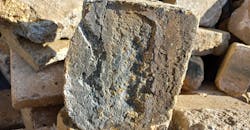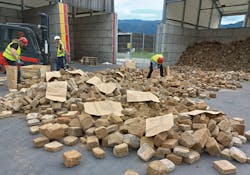Research Seeks to Cut CO2 Emissions from Refractory Recycling
How much do foundry and diecasting operators think about refractory materials? Surely, their choices of furnace and ladle lining material are important to the metallurgical quality of their castings, and the productivity of their melting and holding operations.
But it’s worth noting that there is a significant manufacturing sector behind the materials and products lining foundry vessels, a sector with its own cost and environmental concerns. That production network is important to the foundries that source refractories. And how refractory materials are handled after they have filled their insulating role also should concern metalcasters, particularly as the net-zero-carbon standard gains salience.
Metalcasting and other manufacturing processes result in approximately 28 million metric tons/year of “spent” refractories worldwide, so there could be considerable ecological and societal benefits to improving the refractory recycling sequence.
A research project funded by the European Union is focused on recycling processes used to recover materials after refractories have been spent. The four research bodies and five industry groups in this consortium, known as ReSoURCE, claim their efforts could help cut CO2 emissions by up to 800,000 metric tons annually.The leading researcher is RHI Magnesita, a manufacturer of over 120,000 different refractory varieties for iron and steel and nonferrous metal production, as well as cement making, glassmaking, and other industries. Other participants are offering expertise in geology, laser technology, and hyperspectral imaging. The focus of the effort is to cut CO2 emissions from the process of recycling spent refractories.
“On average, 60% of all spent refractories generated by refractory-consuming industries go to landfill, while only 30% is recycled,” explained RHI Magnesita CEO Stefan Borgas. “With the ReSoURCE project, we aim to increase it up to 75%. This means we can achieve significant savings of CO2 emissions per year.”
The goal of the ReSoURCE consortium is to define and implement a working, sensor-based system for refractory-waste sorting and powder handling. If successful, the project will make it possible to engineer automated sorting equipment that will increase the recycling of refractory breakout material from the current estimate of 7-30% (plus 10% of downcycling) to 80%.
The recycling process being evaluated was designed by Karl Friedrich, an expert in waste management and recycling at the Montanuniversität in Leoben. Prepared samples will be shipped to research specialists at Innolas Laser GmbH, in Germany, and the Norsk Elektro Optik AS, in Norway, who will conduct the initial experiments.
Other partners in the project are LSA GmbH and the Fraunhofer Institute in Germany, SINTEF in Norway, CPI in England. and Crowdhelix in Ireland. The €8.5-million project is funded by the European Health and Digital Executive Agency. It was launched in June 2022 and will continue through November 2025. (42 months).
“We are very much aware that we cannot reach our goal without our partners in Austria, Germany, England, Ireland, and Norway,” according to project manager Saranya Azhaarudeen, who is coordinating the international workflow. “Currently we are working on preparing samples of the used fire-resistant material from steel and cement production.
“I am confident that we will reach our goal in time and am grateful that we were given the financial support that we needed by the European Health and Digital Executive Agency (HaDEA),” Azhaarudeen added.

